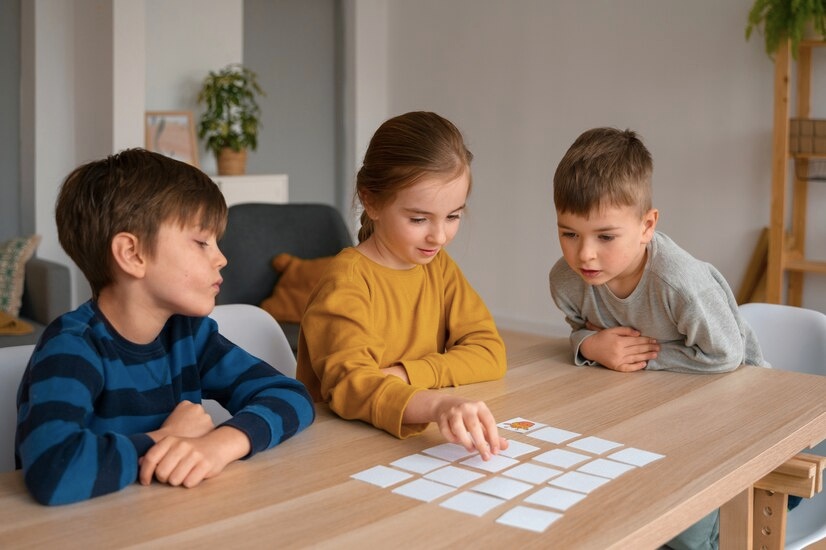- 1. Read Stories to Them to Boost their Imagination
- 2. Set Them on The Road to Autonomy and Decision-making
- 3. Try Gamified Learning
- 4. Take Learning Beyond the Classroom Walls
- 5. Equip the Young Learner with Tools and the Ideal Environment
- 6. Introduce Them to the Concept of Learning by Doing
- 7. Set Achievable Goals
- 8. Celebrate Their Efforts Without Lying to Them
- 9. Be Their Ever-present Co-pilot
- 10. Engage Them in Meaningful Conversations
Nurturing a child’s love for studying is an art, given how creative your approach can be. But a successful journey towards helping your kid foster a love for learning should include a heightened enthusiasm and curiosity about general knowledge. So, how exactly do you achieve that? Let’s find out some of the best ways to do this:
Math & ELA | PreK To Grade 5
Kids see fun.
You see real learning outcomes.
Watch your kids fall in love with math & reading through our scientifically designed curriculum.
Parents, try for free Teachers, use for free
1. Read Stories to Them to Boost their Imagination

Stories are the backbone of any great learning adventure. And until scientists invent the time travel devices you see in sci-fi movies, stories are the closest things to portals into other worlds where minds can roam freely. So, let your child enjoy the experience of bonding over story time while you instill a love of learning in them.
You can start this by reading together. Set a time when you have little to no distractions, and your child is eager for contact with you. If you can, try to work the latter around the former instead of vice versa. That’s so you don’t force your child into the activity.
When you’ve found the ideal time, pick a book on ideas or stories your child is interested in, make sure they are warm and comfortable, turn off your phone notifications, and start reading to them.
Related Reading: Best Children’s Books to Stimulate Kids’ Imagination
2. Set Them on The Road to Autonomy and Decision-making

Imagine your child’s learning journey as a road trip. To make the trip enjoyable, let them have some control over the direction. Offering choices regarding their education gives them a sense of independence and teaches them the concept of consequences. Brighterly and a few other learning platforms have popularized this approach.
Don’t be too scared to give them the burden of responsibility. They will make choices eventually, and training them to become more comfortable with decisions will make their lives much simpler in the future. You can make your kids more autonomous by letting them choose which sport to play, what books to read, and even decide between two or more furniture arrangements in their study room.
3. Try Gamified Learning

Learning should be as exhilarating as a joyride in a classic car, and gamified learning is the key to achieving just that. Kids love playing, and as long as you weave the learning process into their play routine, you will be one step closer to making them embrace the idea of learning new things.
One such platform for gamified learning is SplashLearn. SplashLearn takes the concept of learning through play to a whole new level, offering a range of interactive, curriculum-aligned free online math learning games and reading games for kids from Pre-K to Grade 5. What sets SplashLearn apart is its ability to adapt to each child’s learning pace, providing a personalized learning experience that makes education both effective and fun. With its engaging and colorful interface, children can embark on educational adventures, earn rewards, and face challenges, all while learning fundamental concepts in math and reading.
4. Take Learning Beyond the Classroom Walls

As efficient as math tests for kids are, field trips introduce them to real-life experiences, connecting theory with practice. Whether visiting a science museum, a day at the zoo or exploring nature in a park, these excursions breathe life into textbooks and inspire a genuine love for learning.
Another alternative is to go to festivals or volunteering events and take your child with you. Let them interact, engage with others and get their hands dirty, literally and figuratively. Getting information they never could in the homogenous background of their classrooms will foster love for learning in your kids.
If you prefer to do things from the comfort of your home, take cooking, art, or music classes with your child. You don’t need to hire a professional tutor if you don’t want to. Simply register for online classes or use YouTube. Irrespective of the idea you choose from these recommendations, as long as you show excitement from the first day, your child will be inclined to share in your enthusiasm, thus increasing their likelihood to stick around for the learning process.
5. Equip the Young Learner with Tools and the Ideal Environment

Apart from the right environment, few other things can influence your child’s learning as much as the tools they have to work with. Giving them the right tools, from books to video clips, workbooks, and worksheets, will accelerate their learning rate and interest. And since you can order most things online today, getting these learning aids shouldn’t be as difficult as when you were growing up.
But your job doesn’t end when you pull out your credit or debit card to buy study aids; you must research tools based on your child’s personality. Then, make a study space that calms them and lets them think and read without being distracted. Make the room bright, aerated, dry, and comfortable. If you are unsure how to deck their room out, take the tip from the third point in this article and ask them to choose. Then, fine-tune the arrangement based on your financial capacity and better judgment, but don’t change things too much.
Related Reading: Best Teaching Tools to Use for Uplifting Classroom Standards
6. Introduce Them to the Concept of Learning by Doing

Hands-on learning is like restoring an old motorcycle; it’s about getting your hands dirty and truly understanding the mechanics of things. You’re likely to see students excited about learning when encouraged to experiment, build, and create. While their first attempts may involve a lot of errors, the experience leaves unforgettable memories in their minds.
As long as you support them through every step, they will become better at studying and more interested in it. When teachers inspire students, they end up with better-behaved youths who will make a difference in society. So feel free to be involved in learning alongside your students and teach them to learn through actions. Present theories and give them the chance to prove them right or wrong, play with colors, or engage in any similar activity that makes them more curious and imaginative.
7. Set Achievable Goals

If you overestimate yourself and your child’s abilities, you may set unrealistic goals, which may cause their self-confidence and interest in learning to plummet. But if you start with milestones for assessing each stage of the learning journey, your goal will be more practical. This way, your child will feel motivated to continue their progress and feel a sense of accomplishment with each milestone reached.
8. Celebrate Their Efforts Without Lying to Them

When children love to learn, it’s often because their tutor or parent constantly makes them feel good through encouraging words and constructive feedback. Praising your child doesn’t imply you should lie to them about their progress and gloss over their shortcomings. Praising their determination and persistence fosters a positive attitude towards challenges and growth.
9. Be Their Ever-present Co-pilot
As important as teaching them autonomy is, being your child’s support system is invaluable. Especially in their formative years, your child or student will look to you as a mentor, so be there for them. While you foster a love for learning in your kids, be their confidant, offering assistance, encouragement, and a safe space to explore and learn.
10. Engage Them in Meaningful Conversations

A good discussion is like a friendly chat over dinner — it’s a two-way street. So, to foster a love for learning in your child, avoid the pitfall of doing most of the talking. This tip could be the difference between your students seeing you as a lecturer and them looking up to you.
Engaging in meaningful conversations with children encourages critical thinking, problem-solving, and a deeper understanding of subjects. So, avoid one-sided lectures and invite them to share their thoughts and opinions instead. You could even learn something from them!
11. Make Them Comfortable Enough to Make Mistakes
Encourage your child to explore and learn from their blunders because nothing worthwhile is achieved without errors. Mistakes are valuable opportunities for growth, problem-solving, and resilience.
The difference between greatness and mediocrity may lie in your child’s way of handling mistakes, so teach them to react positively when things don’t go their way during learning. You can teach this by checking your own reactions to their mistakes. If you don’t berate them or judge them harshly, they are unlikely to do that to themselves.
Conclusion
Having gone through these tips, you should understand the importance of fostering a love for learning in children. You can’t achieve this in a day or even a month, but by constantly chipping away at it, you will make your child more interested in learning. Take the tips in this article and add a personal spin based on your situation and your child’s needs. You can foster a love for learning in your students, wards, or kids if you are intentional about it, and the advantages are endless. So start today and enjoy the process!
Related Reading: What is Learning Through Play? Benefits, Ideas & Tips
























